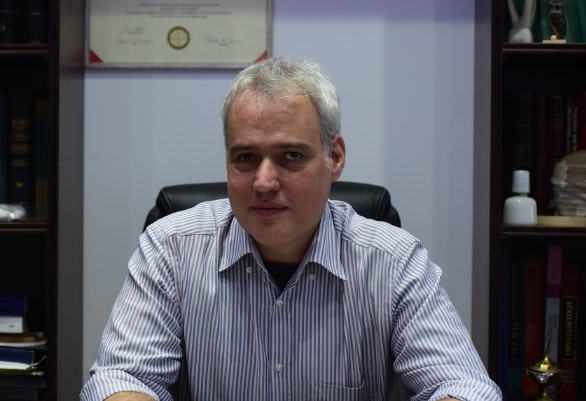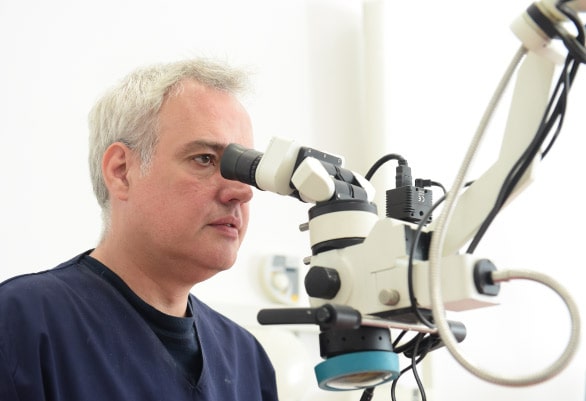Micro Endo
Micro Endo
Dimitris Tsatsas
DDS, MSD, CAGS, PhD
Dental Surgeon, Specialized in Endodontics

Dimitris Tsatsas was born in Athens. He graduated from the Lycee Leonin of Nea Smyrni school and then was admitted through Panhellenic examinations to the School of Dentistry of the National and Kapodistrian University of Athens, from where he graduated with a grade of "very good".
Subsequently, he received a scholarship from the State Scholarships Foundation and the Onassis Foundation to complete three-year postgraduate studies in Endodontics at Boston University, USA (Henry Goldman School of Dental Medicine), from where he received the titles of Master of Science in Dentristry-Oral Biology and Certificate of Advanced Graduate Studies-Endodontics.
During these studies, among other things, he was engaged in in vivo research, at histological and molecular level, on the healing of fractures in diabetes, in collaboration with the Department of Orthopedics of the Medical School of the same University.
His thesis is based on this research, as well as the publication entitled “Diminished bone formation during diabetic fracture healing is related to the premature resorption of cartilage associated with increased osteoclast activity” in the Journal of bone and mineral research (H-Index 262). Thanks to the success of this research, the Department of Oral Biology received a large grant from the American N.I.H. At the same time, he was trained in the field of Endodontics, studying with internationally renowned top Professors, gaining at the same time great clinical experience in various clinics and hospitals (BUSDM, V.A. Hospital, Dorchester House, Commonwealth Av. Clinic) always using a surgical microscope.

Returning to Greece, after fulfilling his military obligations, he completed his doctoral thesis with a grade of "excellent", at the Department of Pathological Anatomy of the Medical School of the University of Athens, engaged in the research of the contribution of PAF (platelet activating factor) in inflammatory processes of periapical lesions of endodontic etiology.
He was also a Scientific Associate of the Department of Endodontics of the School of Dentistry of the National and Kapodistrian University of Athens for 10 years (with teaching duties at undergraduate and postgraduate level) and for one year an Academic Scholar.
Since 2006 he maintains a private dental practice, Micro Endo, where he deals exclusively with the subject of Endodontics (root canal treatment). He also has many years of experience in practicing Endodontics with sedation.
He is a founding member of the Association of Greek Endodontists, of which he is the President since 2023.
He holds degrees in English and French.
Dimitris Tsatsas is the son of Professor Emeritus of Endodontics at the National and Kapodistrian University of Athens, Vasilios Tsatsas.
An endodontist is a dentist with further University education (2 years or more) who specializes in the prevention, diagnosis and treatment of pulp and periapical tissues. This treatment is called endodontic treatment or root canal treatment.
More specifically, the endodontist deals with the differential diagnosis of pain of dental or non-dental etiology, endodontic treatments of teeth with live or dead pulp, the repetition of root canal treatments, the treatment of traumatic dental injuries, endodontic microsurgery, as well as the whitening of endodontically treated teeth.
he endodontist has at his disposal high tech specialized equipment in order to provide successful and as comfortable as possible endodontic treatment for the patient. Endodontists with their advanced training, specialized techniques and superior technologies can perform a successful root canal treatment when a general dentist decides to refer the patient due to anatomical variation of the tooth or technical difficulties. The endodontist is always in close cooperation with the referring general dentist in order to achieve the best and most effective treatment for the patient.
The tooth consists of two parts, the part which is visible in the mouth (molar) and the part which is inside the jaws (root). There are teeth that have one root (single root) and teeth that have more than one root (multi-root). The interior of the root is called the root canal. The root of the tooth is surrounded peripherally by a hard dental substance called bone and internally by another hard substance called dentin. The molar of the tooth is surrounded externally by enamel and internally there is also dentin.
The pulp is a complex network of vessels and nerves located inside the tooth, extending from the molar to the root and surrounded by these hard dental substances. When the pulp of the tooth becomes infected, the inflammatory reaction of the pulp begins, which can be countered by our defense system (reversible) or be more severe and require us to intervene to heal the tooth (irreversible). Infection of the pulp can be done in many ways, but mainly it is caused when oral microbes enter the pulp through various portals (caries, cracks, worn restorations, etc.) edema (swelling). After the endodontic treatment, the symptoms completely disappear and the tooth becomes fully functional.
Endodontic treatment is the process of cleaning and shaping the root canals and then filling them with the appropriate materials per case. The endodontist has at his disposal modern technological equipment (magnification means, rotary root canal preparation instruments, modern root canal obturation techniques, etc.) to achieve the best possible therapeutic result.
In cases where the procedure does not an effectively eliminate the bacterial load, the treatment may fail and it should be repeated. Causes of failure are the complex root canal anatomy, the existence of narrow root canals, iatrogenic incidents or even the delayed placement of the final tooth restorations (fillings, crowns, etc.).
Other causes of long-term failure (failure after a significant period of time) are development of caries under the prosthetic restoration, a tooth fracture or poor restoration. All these reasons can lead an otherwise successful endodontic treatment to failure and require endodontic retreatment.
It is important to emphasize that an endodontic treatment, especially if done by a specialized dentist, the success rate reaches 95%. Modern endodontic techniques and the constantly evolving technology in dental equipment and materials result in high rates of successful treatments.
The proper restoration of endodontically treated teeth is of equal importance as the endodontic treatment. The immediate restoration of the tooth after the endodontic treatment is very important because in this way the success of endodontic treatment is ensured and at the same time the functionality of the tooth is restored. Delayed placement of the proper restoration has as a result the reinfection of the endodontic treatment. Most of these treated teeth suffer from extensive loss of dental substance. The type of restoration depends on the tooth type, the extent of dental substance loss and should be in harmony with the periapical tissues and the aesthetics of the patient.
The goal of conservative endodontic treatment is to achieve a sterile or aseptic pulp cavity, which is then obturated. When this cannot be achieved, we apply Surgical Endodontics.
Nowadays, the surgical endodontic procedure is assisted by modern equipment such as the surgical microscope, ultrasound devices and modern obturation materials, achieving minimal intervention in the involved tissues, essentially establishing the term microsurgical endodontics.
Apicoectomy is the most well-known technique in surgical endodontics. The surgical intervention is done through the soft tissues and the bone surrounding the tooth root, so that the root apex and infected tissues are revealed. In addition to removing pathological periapical tissues, a part of the root tip, about 2-3mm long, is cut off and removed. Then a retrograde filling of biocompatible materials in placed and the incision is sutured.
Traumatic tooth injuries are common, especially in children. They may affect the hard tooth tissues and are classified into cracks, crown fractures with or without involvement of the pulp, horizontal, oblique or vertical root fractures, but they may involve injury to the tooth-supporting structures which are classified as concussion (abnormal loosening or displacement of the tooth), subluxation, luxation either extrusive with partial displacement of the tooth out of its socket, or lateral with displacement of the tooth in a direction other than axially, or intrusive with displacement of the tooth into the alveolar bone and finally avulsion (exarticulation) with complete displacement of the tooth out of its socket.
Long-term manifestations of tooth injury are pulp necrosis, internal or external root resorption of the injured tooth and complete calcification of the pulp cavity and root canal.
It is of vital importance to know that in case the tooth is completely displaced out of its socket (avulsion), it should be immediately transferred to the nearest medical site, ideally within an hour. The transfer should be done in cold milk or special commercial solutions.
The treatment of traumatic tooth injuries depends on the type and severity of the damage, the delay time until treatment, the age of the patient and especially the stage of tooth development in young individuals. The treatment covers a wide range and includes:
- Monitoring of the case with recalls at certain intervals with radiographic and clinical assessment mainly for any color changes of the tooth crown, pulp vitality, calcifications or resorptions
- Pulpotomy, allowing time for the complete conformation of the root
- Endodontic treatment of tooth with incomplete root formation and open foramina with classic or modern techniques (use of MTA, regeneration of pulp tissue)
- Orthodontic or surgical eruption of an intruded tooth
- Tooth replantation
- Immobilization as indicated per case
- Recall examination
Contact
please contact us.